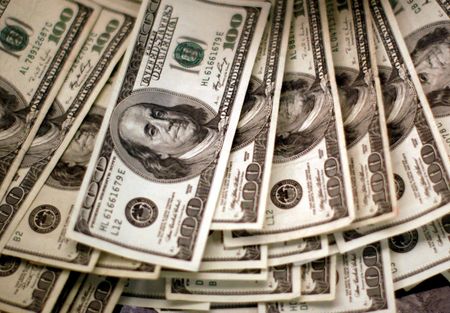By Amanda Cooper
LONDON (Reuters) -The dollar traded at three-month highs on Tuesday as division within the Federal Reserve prompted traders to revise their U.S. rate outlook, while the pound tumbled after the UK finance minister pointed to “hard choices” in her upcoming budget.
Overall market sentiment on Tuesday was noticeably darker, with stocks falling and government bonds drawing in demand, while safe-haven currencies like the yen and the Swiss franc held firm.
DATA GAP LEAVES INVESTORS AND FED IN THE DARK
Fed officials continued offering competing views of where the economy stands and the risks facing it in the absence of economic data suspended due to the shutdown.
The central bank cut rates last week, as expected, while Chair Jerome Powell suggested another cut in December was not a given. Traders now price a 65% chance of a rate cut in December, compared with 94% a week earlier, CME FedWatch showed.
That shift in near-term expectations has boosted the dollar. The dollar index, which measures the U.S. currency against six others, topped 100 for the first time since early August and was last at 99.822.
Sterling fell as much as 0.61% to $1.3057, after Reeves set out the difficult economic backdrop she was wrestling with, pointing to high debt levels, low productivity and stubborn inflation.
“Sterling is repricing lower on the back of what is going to be another round of very stiff headwinds to economic growth,” Pepperstone senior research strategist Michael Brown said.
The pound also fell against the euro, which rose 0.3% to 87.98 pence. The euro was last down 0.2% against the dollar at $1.149, around three-month lows.
With investor risk appetite looking fragile, the Australian dollar was down 0.7% at $0.6495, after the Reserve Bank of Australia left its cash rate steady as expected at 3.60% but cautioned about further easing.
SHUTDOWN STILL GOING ON
With the shutdown in Washington choking off the release of government data, investors are watching non-official reports, including ADP data on private-sector employment.
Monday’s survey of manufacturers in the Institute for Supply Management painted a dire picture of the factory sector, showing U.S. manufacturing contracted for an eighth straight month in October as new orders remained subdued.
Powell’s note of caution on a December cut, on the heels of the Bank of Japan leaving interest rates unchanged last week, has been something of a boon to the yen in the past few days.
The yen strengthened on Tuesday, leaving the dollar down 0.4% at 153.56 yen, having hit an eight-and-a-half-month high earlier.
That peak prompted Japanese Finance Minister Satsuki Katayama to reiterate the government’s intention to continue to monitor foreign exchange movements with a high sense of urgency.
The yen is approaching levels at which Japanese authorities intervened in markets in 2022 and 2024 to support the currency.
U.S. President Donald Trump, who recently visited Japan, has frequently criticised governments that allow their currencies to weaken, on the grounds that it gives them an unfair trade advantage, which might mean Katayama will tread carefully, analysts said.
“The Ministry of Finance, more than any other G7 finance ministry … are very wary about the currency,” Rabobank head of currency strategy Jane Foley said.
“The new Japanese administration are very keen on strengthening relations with Trump. The new prime minister started off well. She’s not going to want to sour that by being associated with a really weak (currency) policy,” she said.
(Additional reporting by Ankur Banerjee in Singapore and Lucy Raitano in London; Editing by Kim Coghill, Conor Humphries and Chizu Nomiyama )










